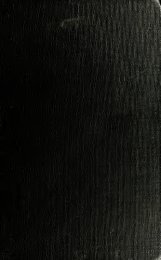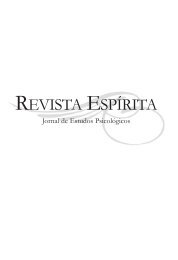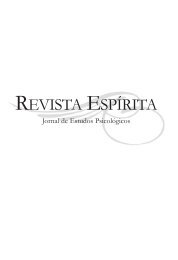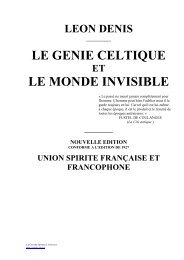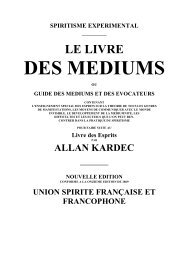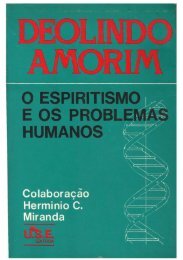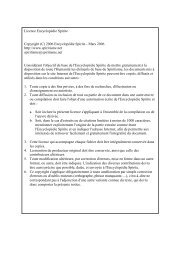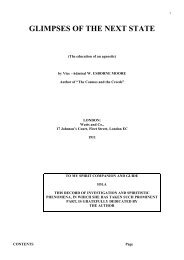'Twixt two worlds : a narrative of the life and work of William Eglinton
'Twixt two worlds : a narrative of the life and work of William Eglinton
'Twixt two worlds : a narrative of the life and work of William Eglinton
You also want an ePaper? Increase the reach of your titles
YUMPU automatically turns print PDFs into web optimized ePapers that Google loves.
"<br />
General Testimony to Psyckography. i I<br />
%<br />
signed Godschall Johnson.' The message was addressed to Captain Darvall, who told us<br />
'<br />
that <strong>the</strong> name was that <strong>of</strong> a deceased relative. This was a very interesting manifestation<br />
to ^one who had never seen anything <strong>of</strong> <strong>the</strong> kind before, <strong>and</strong> my friend did not refuse to<br />
believe <strong>the</strong> evidence <strong>of</strong> his senses. For <strong>the</strong> first time in his <strong>life</strong>, he found himself calmly<br />
saying to a dead man, Well, how are you getting on ' ' I hope that none <strong>of</strong> <strong>the</strong><br />
relatives <strong>of</strong> <strong>the</strong>se friends will blame me for giving <strong>the</strong> names. I can see no reason for<br />
not publishing <strong>the</strong>m, <strong>and</strong> one would think that all who had <strong>the</strong> pleasure <strong>of</strong> knowing <strong>the</strong><br />
spirit, who in this <strong>life</strong> was called Lady Darvall, cannot but rejoice to learn that she is<br />
happy, Tor in <strong>the</strong>se spontaneous communications from unevoked spirits, may we not be<br />
satisfied as to <strong>the</strong> genuineness <strong>of</strong> <strong>the</strong>ir source <br />
A clergyman (I am in possession <strong>of</strong> <strong>the</strong> real name <strong>and</strong> address) also wrote testifying<br />
to Mr. <strong>Eglinton</strong>'s wonderful powers. " It may be useful to mention a simple <strong>and</strong> interesting<br />
test which I applied at <strong>the</strong> second <strong>of</strong> <strong>two</strong> very successful seances which I have attended. More<br />
than once I specially examined <strong>the</strong> ' crumb<br />
'<br />
<strong>of</strong> pencil before it was used. Small, thin pieces,<br />
with sharp edges, are employed. Immediately after a message or answer had been given I<br />
removed <strong>the</strong> pencil from <strong>the</strong> slate, where, as has been noticed by o<strong>the</strong>rs, it lay against <strong>the</strong> last<br />
word <strong>of</strong> <strong>the</strong> communications, <strong>and</strong> I observed that one <strong>of</strong> its angles was freshly worn down,<br />
exactly as would be <strong>the</strong> case in writing. This change in its substance, being produced in<br />
<strong>the</strong> very short interval during which it was placed on <strong>the</strong> slate, or between slates, <strong>and</strong><br />
hidden from view, <strong>and</strong> being coincident with <strong>the</strong> production <strong>of</strong> <strong>the</strong> writing <strong>and</strong> <strong>the</strong> scratching<br />
sound as <strong>of</strong> a pencil on <strong>the</strong> slate, proves as completely as such a thing can be proved that<br />
<strong>the</strong> pencil was used. This evidence, <strong>of</strong> course, confutes <strong>the</strong> suggestion, if it were tenable on<br />
o<strong>the</strong>r grounds, that <strong>the</strong> writing is prepared beforeh<strong>and</strong>. That <strong>the</strong> medium himself h<strong>and</strong>led<br />
<strong>the</strong> tiny fragment <strong>of</strong> pencil as it thus travelled across <strong>the</strong> slate in <strong>the</strong> confined space between<br />
slate <strong>and</strong> table, or between <strong>the</strong> <strong>two</strong> slates pressed toge<strong>the</strong>r, is to those who have watched <strong>the</strong><br />
occurrence in <strong>the</strong> clearest light entirely out <strong>of</strong> <strong>the</strong> question. It is quite possible for a<br />
prejudiced person under <strong>the</strong> guise <strong>of</strong> full examination to annoy a medium with unreasonable<br />
requirements. But <strong>the</strong> c<strong>and</strong>id <strong>and</strong> thorough inquiry into minute particulars which is necessary<br />
in <strong>the</strong> investigation <strong>of</strong> such marvels, Mr. <strong>Eglinton</strong> treats very amiably <strong>and</strong> indeed asks for.<br />
I may suggest that <strong>the</strong> observation <strong>of</strong> <strong>the</strong> slate pencil, as having been actually used when<br />
writing appears, has a place in <strong>the</strong> chain <strong>of</strong> scientific evidence."<br />
The h<strong>and</strong>writing <strong>of</strong> <strong>the</strong>se messages was <strong>of</strong>ten characteristic <strong>of</strong> "<strong>the</strong> dead." A good<br />
case <strong>of</strong> this kind is recorded by Dr. Nichols, who is supported in his testimony by three<br />
o<strong>the</strong>r well-known <strong>and</strong> responsible persons.<br />
" We sat in <strong>the</strong> full daylight round a very plain table for direct writing on slates.<br />
There were five persons present—Mr. Charles Blackburn, Mrs. Western, Miss Cook, Mr. <strong>Eglinton</strong>,<br />
<strong>and</strong> myself." After describing <strong>the</strong> indisputable conditions under which several small messages<br />
were written, Dr. Nichols continues :— " Two slates were cleaned <strong>and</strong> laid upon <strong>the</strong> top <strong>of</strong> <strong>the</strong><br />
table in full sight. A bit <strong>of</strong> pencil, about a quarter <strong>of</strong> an inch long, was placed between <strong>the</strong>m.<br />
All our h<strong>and</strong>s were joined, <strong>and</strong> thus holding each o<strong>the</strong>r we watched <strong>and</strong> listened. In a few<br />
seconds we heard <strong>the</strong> sound <strong>of</strong> rapid writing—<strong>the</strong>n <strong>the</strong> signal raps. Removing <strong>the</strong> upper<br />
slate we found a message (Fig. 19) <strong>of</strong> fifteen lines, containing one hundred <strong>and</strong> twenty-six<br />
words, in a h<strong>and</strong>writing perfectly familiar to me, <strong>and</strong> totally unlike that <strong>of</strong> any person present :<br />
IS



